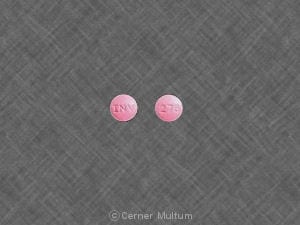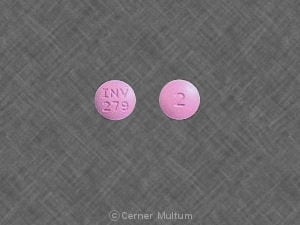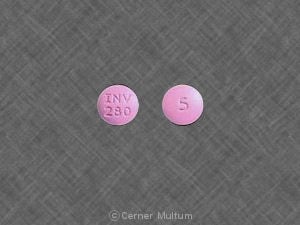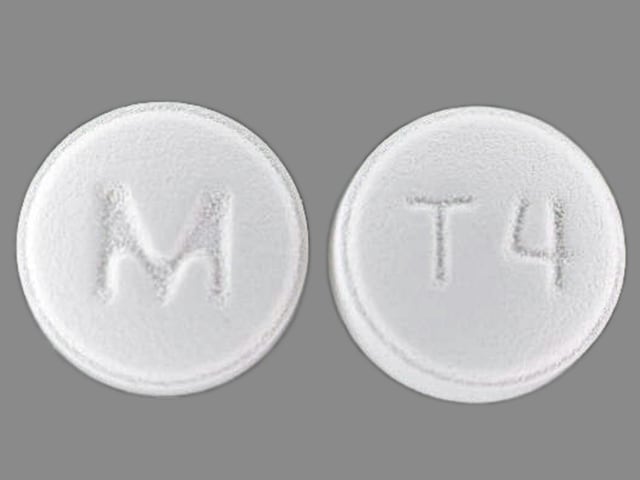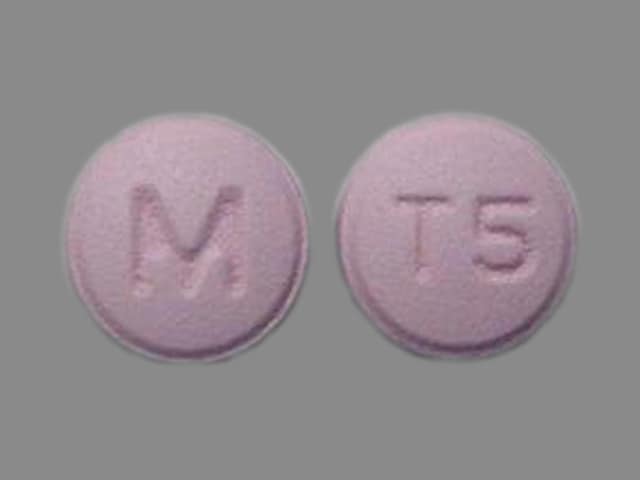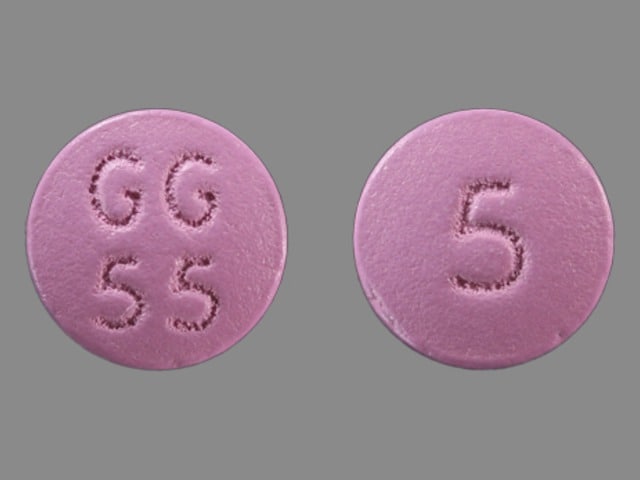Boxed Warning
Increased mortality in elderly patients with dementia-related psychosis:
Elderly patients with dementia-related psychosis treated with antipsychotic drugs are at an increased risk of death. Analyses of 17 placebo-controlled trials (modal duration of 10 weeks), largely in patients taking atypical antipsychotic drugs, revealed a risk of death in drug-treated patients between 1.6 and 1.7 times the risk of death in placebo-treated patients. Over the course of a typical 10-week controlled trial, the rate of death in drug-treated patients was approximately 4.5%, compared to a rate of approximately 2.6% in the placebo group. Although the causes of death were varied, most of the deaths appeared to be either cardiovascular (eg, heart failure, sudden death) or infectious (eg, pneumonia) in nature. Observational studies suggest that, similar to atypical antipsychotic drugs, treatment with conventional antipsychotic drugs may increase mortality. The extent to which the findings of increased mortality in observational studies may be attributed to the antipsychotic drug as opposed to some characteristic(s) of the patients is not clear. Trifluoperazine is not approved for the treatment of patients with dementia-related psychosis.
Dosage Forms
Excipient information presented when available (limited, particularly for generics); consult specific product labeling.
Tablet, Oral:
Generic: 1 mg, 2 mg, 5 mg, 10 mg
Pharmacology
Mechanism of Action
Trifluoperazine is a piperazine phenothiazine antipsychotic which blocks dopamine, subtype 2 (D2), receptors in mesolimbocortical and nigrostriatal areas of the brain (APA [Lehman, 2004]).
Pharmacokinetics/Pharmacodynamics
Metabolism
Metabolized in the gut after administration and hepatically to active metabolites N-desmethyltrifluoperazine, 7-hydroxyrifluoperazine, and other metabolites (Midha 1984).
Onset of Action
For control of agitation, aggression, hostility: 2 to 4 weeks; For control of psychotic symptoms (hallucinations, disorganized thinking or behavior, delusions): Within 1 week; Adequate trial: 6 weeks at moderate to high dose based on tolerability
Time to Peak
Serum: 1.5 to 6 hours (Midha 1984)
Duration of Action
Variable
Half-Life Elimination
3 to 12 hours (Midha 1984)
Use: Labeled Indications
Nonpsychotic anxiety: Short-term treatment of generalized nonpsychotic anxiety.
Schizophrenia: Management of schizophrenia.
Use: Off Label
Psychosis/agitation associated with dementiayes
Based on the American Psychiatric Association (APA) practice guideline on the use of antipsychotics to treat agitation or psychosis in patients with dementia, antipsychotics, such as trifluoperazine. may be considered for the management of this condition in certain patients; however, evidence for efficacy is modest and use should be limited to patients whose symptoms are dangerous, severe, or cause significant patient distress due to safety risks associated with antipsychotic use. Additionally, the guidelines recommend giving preference to second generation antipsychotics over first generation antipsychotics like trifluoperazine in elderly patients with dementia-related psychosis due to a potentially greater risk of harm relative to second generation antipsychotics.
Contraindications
Hypersensitivity to trifluoperazine, phenothiazines, or any component of the formulation; comatose or greatly depressed states due to CNS depressants; bone marrow suppression; blood dyscrasias; hepatic disease
Dosage and Administration
Dosing: Adult
Nonpsychotic anxiety: Oral: 1 or 2 mg twice daily; titrate dose gradually based on response and tolerability; maximum: 6 mg/day; therapy for anxiety should not exceed 12 weeks; do not exceed 6 mg/day for longer than 12 weeks when treating anxiety because of risks for tardive dyskinesia
Schizophrenia: Oral: Initial: 2 to 5 mg twice daily; titrate dose gradually based on response and tolerability; usual dosage: 15 or 20 mg/day in divided doses although some patients may require up to 50 mg/day (APA [Lehman 2004])
Discontinuation of therapy: American Psychiatric Association (APA), Canadian Psychiatric Association (CPA), and World Federation of Societies of Biological Psychiatry (WFSBP) guidelines recommend gradually tapering antipsychotics to avoid withdrawal symptoms and minimize the risk of relapse (APA [Lehman 2004]; Cerovecki 2013; CPA 2005; WFSBP [Hasan 2012]); risk for withdrawal symptoms may be highest with highly anti-cholinergic or dopaminergic antipsychotics (Cerovecki 2013). When stopping antipsychotic therapy in patients with schizophrenia, the CPA guidelines recommend a gradual taper over 6 to 24 months, and the APA guidelines recommend reducing the dose by 10% each month (APA [Lehman 2004]; CPA 2005). Continuing anti-parkinsonism agents for a brief period after discontinuation may prevent withdrawal symptoms (Cerovecki 2013). When switching antipsychotics, 3 strategies have been suggested: cross-titration (gradually discontinuing the first antipsychotic while gradually increasing the new antipsychotic), overlap and taper (maintaining the dose of the first antipsychotic while gradually increasing the new antipsychotic, then tapering the first antipsychotic), and abrupt change (abruptly discontinuing the first antipsychotic and either increasing the new antipsychotic gradually or starting it at a treatment dose). Evidence supporting ideal switch strategies and taper rates is limited, and results are conflicting (Cerovecki 2013; Remington 2005).
Dosing: Geriatric
Refer to adult dosing. Dose selection should start at the low end of the dosage range and titration must be gradual.
Psychosis/agitation associated with dementia (off-label use): Oral: Initial: One-third to one-half the usual dose to treat psychosis in younger adults or the smallest available dosage. In patients without a clinically significant response after 4 weeks, taper and withdraw therapy. In patients with an adequate response, attempt to taper and withdraw therapy within 4 months, unless symptoms recurred with a previous taper attempt. Assess symptoms at least monthly during taper and for at least 4 months after withdrawal of therapy (APA [Reus 2016]).
Dosing: Pediatric
Schizophrenia: Note: Use has been replaced by newer agents (AACAP [McClellan 2007]; NICE 2013). Dosage should be individualized; use lowest effective dose and shortest effective duration; periodically reassess the need for continued treatment:
Children 6 to 12 years: Hospitalized or well-supervised patients: Initial: Oral: 1 mg administered 1 to 2 times daily; gradually titrate to effects as tolerated; daily maintenance range: 1 to 15 mg/day in 1 to 2 divided doses; usual maximum daily dose: 15 mg/day; older children with severe symptoms may require higher doses
Adolescent: Initial: 2 to 5 mg twice daily; gradually titrate dose as tolerated; usual maintenance dose range: 15 to 20 mg/day in 2 divided doses; maximum daily dose: 40 mg/day; in small for age patients, consider initial doses at the lower end of the range
Discontinuation of therapy: Children and Adolescents: American Academy of Child and Adolescent Psychiatry (AACAP), American Psychiatric Association (APA), Canadian Psychiatric Association (CPA), National Institute for Health and Care Excellence (NICE), and World Federation of Societies of Biological Psychiatry (WFSBP) guidelines recommend gradually tapering antipsychotics to avoid withdrawal symptoms and minimize the risk of relapse (AACAP [McClellan 2007]; APA [Lehman 2004]; Cerovecki 2013; CPA 2005; NICE 2013; WFSBP [Hasan 2012]); risk for withdrawal symptoms may be highest with highly anticholinergic or dopaminergic antipsychotics (Cerovecki 2013). When stopping antipsychotic therapy in patients with schizophrenia, the CPA guidelines recommend a gradual taper over 6 to 24 months and the APA guidelines recommend reducing the dose by 10% each month (APA [Lehman 2004]; CPA 2005). Continuing antiparkinsonism agents for a brief period after discontinuation may prevent withdrawal symptoms (Cerovecki 2013). When switching antipsychotics, three strategies have been suggested: Cross-titration (gradually discontinuing the first antipsychotic while gradually increasing the new antipsychotic), overlap and taper (maintaining the dose of the first antipsychotic while gradually increasing the new antipsychotic, then tapering the first antipsychotic), and abrupt change (abruptly discontinuing the first antipsychotic and either increasing the new antipsychotic gradually or starting it at a treatment dose). Evidence supporting ideal switch strategies and taper rates is limited and results are conflicting (Cerovecki 2013; Remington 2005).
Storage
Store at 20°C to 25°C (68°F to 77°F). Protect from moisture and light
Trifluoperazine Images
Drug Interactions
Acetylcholinesterase Inhibitors: May diminish the therapeutic effect of Anticholinergic Agents. Anticholinergic Agents may diminish the therapeutic effect of Acetylcholinesterase Inhibitors. Monitor therapy
Acetylcholinesterase Inhibitors (Central): May enhance the neurotoxic (central) effect of Antipsychotic Agents. Severe extrapyramidal symptoms have occurred in some patients. Monitor therapy
Aclidinium: May enhance the anticholinergic effect of Anticholinergic Agents. Avoid combination
Alcohol (Ethyl): CNS Depressants may enhance the CNS depressant effect of Alcohol (Ethyl). Monitor therapy
Alizapride: May enhance the CNS depressant effect of CNS Depressants. Monitor therapy
Amifampridine: Agents With Seizure Threshold Lowering Potential may enhance the neuroexcitatory and/or seizure-potentiating effect of Amifampridine. Monitor therapy
Aminolevulinic Acid (Systemic): Photosensitizing Agents may enhance the photosensitizing effect of Aminolevulinic Acid (Systemic). Avoid combination
Aminolevulinic Acid (Topical): Photosensitizing Agents may enhance the photosensitizing effect of Aminolevulinic Acid (Topical). Monitor therapy
Amisulpride: Antipsychotic Agents may enhance the adverse/toxic effect of Amisulpride. Management: Drugs listed as exceptions to this monograph are discussed in further detail in separate drug interaction monographs. Avoid combination
Amphetamines: Antipsychotic Agents may diminish the stimulatory effect of Amphetamines. Monitor therapy
Antacids: May decrease the absorption of Antipsychotic Agents (Phenothiazines). Monitor therapy
Anticholinergic Agents: May enhance the adverse/toxic effect of other Anticholinergic Agents. Monitor therapy
Antimalarial Agents: May increase the serum concentration of Antipsychotic Agents (Phenothiazines). Monitor therapy
Anti-Parkinson Agents (Dopamine Agonist): Antipsychotic Agents (First Generation [Typical]) may diminish the therapeutic effect of Anti-Parkinson Agents (Dopamine Agonist). Anti-Parkinson Agents (Dopamine Agonist) may diminish the therapeutic effect of Antipsychotic Agents (First Generation [Typical]). Management: Avoid concomitant therapy if possible and monitor for decreased effects of both agents when these combinations cannot be avoided. Atypical antipsychotics such as clozapine and quetiapine may be less likely to reduce the effects of anti-Parkinson agents. Consider therapy modification
Azelastine (Nasal): CNS Depressants may enhance the CNS depressant effect of Azelastine (Nasal). Avoid combination
Beta-Blockers: Antipsychotic Agents (Phenothiazines) may enhance the hypotensive effect of Beta-Blockers. Beta-Blockers may decrease the metabolism of Antipsychotic Agents (Phenothiazines). Antipsychotic Agents (Phenothiazines) may decrease the metabolism of Beta-Blockers. Exceptions: Atenolol; Levobunolol; Metipranolol; Nadolol. Monitor therapy
Blonanserin: CNS Depressants may enhance the CNS depressant effect of Blonanserin. Consider therapy modification
Botulinum Toxin-Containing Products: May enhance the anticholinergic effect of Anticholinergic Agents. Monitor therapy
Brexanolone: CNS Depressants may enhance the CNS depressant effect of Brexanolone. Monitor therapy
Brimonidine (Topical): May enhance the CNS depressant effect of CNS Depressants. Monitor therapy
Bromopride: May enhance the adverse/toxic effect of Antipsychotic Agents. Avoid combination
Bromperidol: May enhance the CNS depressant effect of CNS Depressants. Avoid combination
Buprenorphine: CNS Depressants may enhance the CNS depressant effect of Buprenorphine. Management: Consider reduced doses of other CNS depressants, and avoiding such drugs in patients at high risk of buprenorphine overuse/self-injection. Initiate buprenorphine at lower doses in patients already receiving CNS depressants. Consider therapy modification
BuPROPion: May enhance the neuroexcitatory and/or seizure-potentiating effect of Agents With Seizure Threshold Lowering Potential. Monitor therapy
Cannabidiol: May enhance the CNS depressant effect of CNS Depressants. Monitor therapy
Cannabis: May enhance the CNS depressant effect of CNS Depressants. Monitor therapy
Chloral Betaine: May enhance the adverse/toxic effect of Anticholinergic Agents. Monitor therapy
Chlormethiazole: May enhance the CNS depressant effect of CNS Depressants. Management: Monitor closely for evidence of excessive CNS depression. The chlormethiazole labeling states that an appropriately reduced dose should be used if such a combination must be used. Consider therapy modification
Chlorphenesin Carbamate: May enhance the adverse/toxic effect of Antipsychotic Agents (Phenothiazines). Monitor therapy
Chlorphenesin Carbamate: May enhance the adverse/toxic effect of CNS Depressants. Monitor therapy
Cimetropium: Anticholinergic Agents may enhance the anticholinergic effect of Cimetropium. Avoid combination
CNS Depressants: May enhance the adverse/toxic effect of other CNS Depressants. Monitor therapy
Deutetrabenazine: May enhance the adverse/toxic effect of Antipsychotic Agents. Specifically, the risk for akathisia, parkinsonism, or neuroleptic malignant syndrome may be increased. Monitor therapy
Dimethindene (Topical): May enhance the CNS depressant effect of CNS Depressants. Monitor therapy
Doxylamine: May enhance the CNS depressant effect of CNS Depressants. Management: The manufacturer of Diclegis (doxylamine/pyridoxine), intended for use in pregnancy, specifically states that use with other CNS depressants is not recommended. Monitor therapy
Dronabinol: May enhance the CNS depressant effect of CNS Depressants. Monitor therapy
Droperidol: May enhance the CNS depressant effect of CNS Depressants. Management: Consider dose reductions of droperidol or of other CNS agents (eg, opioids, barbiturates) with concomitant use. Exceptions to this monograph are discussed in further detail in separate drug interaction monographs. Consider therapy modification
Eluxadoline: Anticholinergic Agents may enhance the constipating effect of Eluxadoline. Avoid combination
Esketamine: May enhance the CNS depressant effect of CNS Depressants. Monitor therapy
Flunitrazepam: CNS Depressants may enhance the CNS depressant effect of Flunitrazepam. Consider therapy modification
Gastrointestinal Agents (Prokinetic): Anticholinergic Agents may diminish the therapeutic effect of Gastrointestinal Agents (Prokinetic). Monitor therapy
Glucagon: Anticholinergic Agents may enhance the adverse/toxic effect of Glucagon. Specifically, the risk of gastrointestinal adverse effects may be increased. Monitor therapy
Glycopyrrolate (Oral Inhalation): Anticholinergic Agents may enhance the anticholinergic effect of Glycopyrrolate (Oral Inhalation). Avoid combination
Glycopyrronium (Topical): May enhance the anticholinergic effect of Anticholinergic Agents. Avoid combination
Guanethidine: Antipsychotic Agents may diminish the therapeutic effect of Guanethidine. Monitor therapy
HYDROcodone: CNS Depressants may enhance the CNS depressant effect of HYDROcodone. Management: Avoid concomitant use of hydrocodone and benzodiazepines or other CNS depressants when possible. These agents should only be combined if alternative treatment options are inadequate. If combined, limit the dosages and duration of each drug. Consider therapy modification
HydrOXYzine: May enhance the CNS depressant effect of CNS Depressants. Monitor therapy
Iohexol: Agents With Seizure Threshold Lowering Potential may enhance the adverse/toxic effect of Iohexol. Specifically, the risk for seizures may be increased. Management: Discontinue agents that may lower the seizure threshold 48 hours prior to intrathecal use of iohexol. Wait at least 24 hours after the procedure to resume such agents. In nonelective procedures, consider use of prophylactic anticonvulsants. Consider therapy modification
Iomeprol: Agents With Seizure Threshold Lowering Potential may enhance the adverse/toxic effect of Iomeprol. Specifically, the risk for seizures may be increased. Management: Discontinue agents that may lower the seizure threshold 48 hours prior to intrathecal use of iomeprol. Wait at least 24 hours after the procedure to resume such agents. In nonelective procedures, consider use of prophylactic anticonvulsants. Consider therapy modification
Iopamidol: Agents With Seizure Threshold Lowering Potential may enhance the adverse/toxic effect of Iopamidol. Specifically, the risk for seizures may be increased. Management: Discontinue agents that may lower the seizure threshold 48 hours prior to intrathecal use of iopamidol. Wait at least 24 hours after the procedure to resume such agents. In nonelective procedures, consider use of prophylactic anticonvulsants. Consider therapy modification
Ipratropium (Oral Inhalation): May enhance the anticholinergic effect of Anticholinergic Agents. Avoid combination
Itopride: Anticholinergic Agents may diminish the therapeutic effect of Itopride. Monitor therapy
Kava Kava: May enhance the adverse/toxic effect of CNS Depressants. Monitor therapy
Lemborexant: May enhance the CNS depressant effect of CNS Depressants. Management: Dosage adjustments of lemborexant and of concomitant CNS depressants may be necessary when administered together because of potentially additive CNS depressant effects. Close monitoring for CNS depressant effects is necessary. Consider therapy modification
Levosulpiride: Anticholinergic Agents may diminish the therapeutic effect of Levosulpiride. Avoid combination
Lithium: May enhance the neurotoxic effect of Antipsychotic Agents. Lithium may decrease the serum concentration of Antipsychotic Agents. Specifically noted with chlorpromazine. Monitor therapy
Lofexidine: May enhance the CNS depressant effect of CNS Depressants. Management: Drugs listed as exceptions to this monograph are discussed in further detail in separate drug interaction monographs. Monitor therapy
Magnesium Sulfate: May enhance the CNS depressant effect of CNS Depressants. Monitor therapy
Mequitazine: Antipsychotic Agents may enhance the arrhythmogenic effect of Mequitazine. Management: Consider alternatives to one of these agents when possible. While this combination is not specifically contraindicated, mequitazine labeling describes this combination as discouraged. Consider therapy modification
Methotrimeprazine: CNS Depressants may enhance the CNS depressant effect of Methotrimeprazine. Methotrimeprazine may enhance the CNS depressant effect of CNS Depressants. Management: Reduce adult dose of CNS depressant agents by 50% with initiation of concomitant methotrimeprazine therapy. Further CNS depressant dosage adjustments should be initiated only after clinically effective methotrimeprazine dose is established. Consider therapy modification
Methylphenidate: Antipsychotic Agents may enhance the adverse/toxic effect of Methylphenidate. Methylphenidate may enhance the adverse/toxic effect of Antipsychotic Agents. Monitor therapy
Metoclopramide: May enhance the adverse/toxic effect of Antipsychotic Agents. Avoid combination
MetyroSINE: CNS Depressants may enhance the sedative effect of MetyroSINE. Monitor therapy
MetyroSINE: May enhance the adverse/toxic effect of Antipsychotic Agents. Monitor therapy
Mianserin: May enhance the anticholinergic effect of Anticholinergic Agents. Monitor therapy
Minocycline (Systemic): May enhance the CNS depressant effect of CNS Depressants. Monitor therapy
Mirabegron: Anticholinergic Agents may enhance the adverse/toxic effect of Mirabegron. Monitor therapy
Nabilone: May enhance the CNS depressant effect of CNS Depressants. Monitor therapy
Nitroglycerin: Anticholinergic Agents may decrease the absorption of Nitroglycerin. Specifically, anticholinergic agents may decrease the dissolution of sublingual nitroglycerin tablets, possibly impairing or slowing nitroglycerin absorption. Monitor therapy
Opioid Agonists: CNS Depressants may enhance the CNS depressant effect of Opioid Agonists. Management: Avoid concomitant use of opioid agonists and benzodiazepines or other CNS depressants when possible. These agents should only be combined if alternative treatment options are inadequate. If combined, limit the dosages and duration of each drug. Consider therapy modification
Orphenadrine: CNS Depressants may enhance the CNS depressant effect of Orphenadrine. Avoid combination
Oxatomide: May enhance the anticholinergic effect of Anticholinergic Agents. Avoid combination
Oxomemazine: May enhance the CNS depressant effect of CNS Depressants. Avoid combination
OxyCODONE: CNS Depressants may enhance the CNS depressant effect of OxyCODONE. Management: Avoid concomitant use of oxycodone and benzodiazepines or other CNS depressants when possible. These agents should only be combined if alternative treatment options are inadequate. If combined, limit the dosages and duration of each drug. Consider therapy modification
Paraldehyde: CNS Depressants may enhance the CNS depressant effect of Paraldehyde. Avoid combination
Perampanel: May enhance the CNS depressant effect of CNS Depressants. Management: Patients taking perampanel with any other drug that has CNS depressant activities should avoid complex and high-risk activities, particularly those such as driving that require alertness and coordination, until they have experience using the combination. Consider therapy modification
Piribedil: Antipsychotic Agents may diminish the therapeutic effect of Piribedil. Piribedil may diminish the therapeutic effect of Antipsychotic Agents. Management: Use of piribedil with antiemetic neuroleptics is contraindicated, and use with antipsychotic neuroleptics, except for clozapine, is not recommended. Avoid combination
Porfimer: Photosensitizing Agents may enhance the photosensitizing effect of Porfimer. Monitor therapy
Potassium Chloride: Anticholinergic Agents may enhance the ulcerogenic effect of Potassium Chloride. Management: Patients on drugs with substantial anticholinergic effects should avoid using any solid oral dosage form of potassium chloride. Avoid combination
Potassium Citrate: Anticholinergic Agents may enhance the ulcerogenic effect of Potassium Citrate. Avoid combination
Pramlintide: May enhance the anticholinergic effect of Anticholinergic Agents. These effects are specific to the GI tract. Consider therapy modification
Quinagolide: Antipsychotic Agents may diminish the therapeutic effect of Quinagolide. Monitor therapy
Ramosetron: Anticholinergic Agents may enhance the constipating effect of Ramosetron. Monitor therapy
Revefenacin: Anticholinergic Agents may enhance the anticholinergic effect of Revefenacin. Avoid combination
Rufinamide: May enhance the adverse/toxic effect of CNS Depressants. Specifically, sleepiness and dizziness may be enhanced. Monitor therapy
Saquinavir: Antipsychotic Agents (Phenothiazines) may enhance the arrhythmogenic effect of Saquinavir. Management: Drugs listed as exceptions to this monograph are discussed in further detail in separate drug interaction monographs. Avoid combination
Secretin: Anticholinergic Agents may diminish the therapeutic effect of Secretin. Management: Avoid concomitant use of anticholinergic agents and secretin. Discontinue anticholinergic agents at least 5 half-lives prior to administration of secretin. Consider therapy modification
Selective Serotonin Reuptake Inhibitors: CNS Depressants may enhance the adverse/toxic effect of Selective Serotonin Reuptake Inhibitors. Specifically, the risk of psychomotor impairment may be enhanced. Monitor therapy
Serotonergic Agents (High Risk): May enhance the adverse/toxic effect of Antipsychotic Agents. Specifically, serotonergic agents may enhance dopamine blockade, possibly increasing the risk for neuroleptic malignant syndrome. Antipsychotic Agents may enhance the serotonergic effect of Serotonergic Agents (High Risk). This could result in serotonin syndrome. Monitor therapy
Serotonin Reuptake Inhibitor/Antagonists: Antipsychotic Agents (Phenothiazines) may enhance the adverse/toxic effect of Serotonin Reuptake Inhibitor/Antagonists. Specifically, this may be manifest as symptoms consistent with serotonin syndrome or neuroleptic malignant syndrome. Serotonin Reuptake Inhibitor/Antagonists may enhance the hypotensive effect of Antipsychotic Agents (Phenothiazines). Monitor therapy
Sodium Oxybate: May enhance the CNS depressant effect of CNS Depressants. Management: Consider alternatives to combined use. When combined use is needed, consider minimizing doses of one or more drugs. Use of sodium oxybate with alcohol or sedative hypnotics is contraindicated. Consider therapy modification
Sulpiride: Antipsychotic Agents may enhance the adverse/toxic effect of Sulpiride. Avoid combination
Suvorexant: CNS Depressants may enhance the CNS depressant effect of Suvorexant. Management: Dose reduction of suvorexant and/or any other CNS depressant may be necessary. Use of suvorexant with alcohol is not recommended, and the use of suvorexant with any other drug to treat insomnia is not recommended. Consider therapy modification
Tapentadol: May enhance the CNS depressant effect of CNS Depressants. Management: Avoid concomitant use of tapentadol and benzodiazepines or other CNS depressants when possible. These agents should only be combined if alternative treatment options are inadequate. If combined, limit the dosages and duration of each drug. Consider therapy modification
Tetrabenazine: May enhance the adverse/toxic effect of Antipsychotic Agents. Monitor therapy
Tetrahydrocannabinol: May enhance the CNS depressant effect of CNS Depressants. Monitor therapy
Tetrahydrocannabinol and Cannabidiol: May enhance the CNS depressant effect of CNS Depressants. Monitor therapy
Thalidomide: CNS Depressants may enhance the CNS depressant effect of Thalidomide. Avoid combination
Thiazide and Thiazide-Like Diuretics: Anticholinergic Agents may increase the serum concentration of Thiazide and Thiazide-Like Diuretics. Monitor therapy
Thiopental: Antipsychotic Agents (Phenothiazines) may enhance the adverse/toxic effect of Thiopental. Monitor therapy
Tiotropium: Anticholinergic Agents may enhance the anticholinergic effect of Tiotropium. Avoid combination
Topiramate: Anticholinergic Agents may enhance the adverse/toxic effect of Topiramate. Monitor therapy
Trimeprazine: May enhance the CNS depressant effect of CNS Depressants. Monitor therapy
Umeclidinium: May enhance the anticholinergic effect of Anticholinergic Agents. Avoid combination
Verteporfin: Photosensitizing Agents may enhance the photosensitizing effect of Verteporfin. Monitor therapy
Zolpidem: CNS Depressants may enhance the CNS depressant effect of Zolpidem. Management: Reduce the Intermezzo brand sublingual zolpidem adult dose to 1.75 mg for men who are also receiving other CNS depressants. No such dose change is recommended for women. Avoid use with other CNS depressants at bedtime; avoid use with alcohol. Consider therapy modification
Test Interactions
Phenothiazines may produce a false-positive for phenylketonuria
Adverse Reactions
Frequency not defined.
Cardiovascular: Hypotension, orthostatic hypotension
Central nervous system: Decreased seizure threshold, dizziness, disruption of body temperature regulation, extrapyramidal reaction (akathisia, dystonia, Parkinsonian-like syndrome, tardive dyskinesia), headache, neuroleptic malignant syndrome (NMS)
Dermatologic: Skin discoloration (blue-gray), skin photosensitivity (includes increased sensitivity to sun), skin rash
Endocrine & metabolic: Change in libido, change in menstrual flow, galactorrhea, gynecomastia, hyperglycemia, hypoglycemia, weight gain
Gastrointestinal: Constipation, nausea, stomach pain, vomiting, xerostomia
Genitourinary: Difficulty in micturition, ejaculatory disorder, lactation, mastalgia, priapism, urinary retention
Hematologic & oncologic: Agranulocytosis, aplastic anemia, eosinophilia, hemolytic anemia, immune thrombocytopenia, leukopenia, pancytopenia
Hepatic: Cholestatic jaundice, hepatotoxicity
Neuromuscular & skeletal: Tremor
Ophthalmic: Corneal changes, lens disease, retinitis pigmentosa
Respiratory: Nasal congestion
Warnings/Precautions
Concerns related to adverse effects:
- Altered cardiac conduction: May alter cardiac conduction; life-threatening arrhythmias have occurred with therapeutic doses of antipsychotics (Haddad 2002; Stollberger 2005).
- Anticholinergic effects: May cause anticholinergic effects (constipation, xerostomia, blurred vision, urinary retention); use with caution in patients with decreased gastrointestinal motility, paralytic ileus, urinary retention, BPH, xerostomia, or visual problems. Relative to other antipsychotics, trifluoperazine has a high potency of cholinergic blockade (Tardy 2014).
- Antiemetic effects: May mask toxicity of other drugs or conditions (eg, intestinal obstruction, Reye syndrome, brain tumor) due to antiemetic effects.
- Blood dyscrasias: Leukopenia, neutropenia, thrombocytopenia, anemia, agranulocytosis (sometimes fatal), and pancytopenia have been reported in clinical trials and postmarketing reports with antipsychotic use; presence of risk factors (eg, preexisting low WBC or history of drug-induced leuko-/neutropenia) should prompt periodic blood count assessment. Discontinue therapy at first signs of blood dyscrasias or if absolute neutrophil count <1,000/mm3.
- CNS depression: May cause CNS depression, which may impair physical or mental abilities; patients must be cautioned about performing tasks that require mental alertness (eg, operating machinery, driving).
- Esophageal dysmotility/Aspiration: Antipsychotic use has been associated with esophageal dysmotility and aspiration; risk increases with age. Use with caution in patients at risk for aspiration pneumonia (ie, Alzheimer disease), particularly in patients >75 years (Herzig 2017; Maddalena 2004).
- Extrapyramidal symptoms (EPS): May cause EPS, including pseudoparkinsonism, acute dystonic reactions, akathisia, and tardive dyskinesia. Risk of dystonia (and possibly other EPS) may be greater with increased doses, use of conventional antipsychotics, males, and younger patients. Factors associated with greater vulnerability to tardive dyskinesia include older in age, female gender combined with postmenopausal status, Parkinson disease, pseudoparkinsonism symptoms, affective disorders (particularly major depressive disorder), concurrent medical diseases such as diabetes, previous brain damage, alcoholism, poor treatment response, and use of high doses of antipsychotics (APA [Lehman 2004]; Soares-Weiser 2007). Consider therapy discontinuation with signs/symptoms of tardive dyskinesia.
- Hepatic effects: Liver damage and jaundice of the cholestatic type of hepatitis have been reported with use.
- Hyperprolactinemia: Use associated with increased prolactin levels; clinical significance of hyperprolactinemia in patients with breast cancer or other prolactin-dependent tumors is unknown.
- Neuroleptic malignant syndrome (NMS): May be associated with NMS; monitor for mental status changes, fever, muscle rigidity, and/or autonomic instability. Following recovery from NMS, reintroduction of drug therapy should be carefully considered; if an antipsychotic agent is resumed, monitor closely for NMS.
- Ocular effects: May cause pigmentary retinopathy, and lenticular and corneal deposits, particularly with prolonged therapy (Oshika 1995).
- Orthostatic hypotension: May cause orthostatic hypotension; use with caution in patients at risk of this effect or in those who would not tolerate transient hypotensive episodes (cerebrovascular disease, cardiovascular disease, hypovolemia, or concurrent medication use which may predispose to hypotension/bradycardia) (APA [Lehman 2004]).
- Temperature regulation: Impaired core body temperature regulation may occur; caution with strenuous exercise, heat exposure, dehydration, and concomitant medication possessing anticholinergic effects (Kwok 2005; Martinez 2002).
Disease-related concerns:
- Cardiovascular disease: Use with caution in patients with cardiovascular disease.
- Dementia: [US Boxed Warning]: Elderly patients with dementia-related psychosis treated with antipsychotics are at an increased risk of death compared to placebo. Most deaths appeared to be either cardiovascular (eg, heart failure, sudden death) or infectious (eg, pneumonia) in nature. Use with caution in patients with Lewy body dementia or Parkinson disease dementia due to greater risk of adverse effects, increased sensitivity to extrapyramidal effects, and association with irreversible cognitive decompensation or death. The APA recommends giving preference to second generation antipsychotics over first generation antipsychotics in elderly patients with dementia-related psychosis due to a potentially greater risk of harm relative to second generation antipsychotics (APA [Reus 2016]). Trifluoperazine is not approved for the treatment of dementia-related psychosis.
- Hepatic impairment: Contraindicated in patients with hepatic disease.
- Seizure disorder: Use with caution in patients at risk of seizures, including those with a history of seizures; first-generation antipsychotics may lower the seizure threshold (APA [Lehman 2004]).
Concurrent drug therapy issues:
- Drug-drug interactions: Potentially significant interactions may exist, requiring dose or frequency adjustment, additional monitoring, and/or selection of alternative therapy. Consult drug interactions database for more detailed information.
Other warnings/precautions:
- Appropriate use: Anxiety: Trifluoperazine is not the first drug of choice for most patients with nonpsychotic anxiety. Do not exceed recommended dose and duration; use of trifluoperazine at higher doses or for longer intervals may cause persistent tardive dyskinesia (may be irreversible).
- Discontinuation of therapy: When discontinuing antipsychotic therapy, the American Psychiatric Association (APA), Canadian Psychiatric Association (CPA), and World Federation of Societies of Biological Psychiatry (WFSBP) guidelines recommend gradually tapering antipsychotics to avoid physical withdrawal symptoms, including anorexia, anxiety, diaphoresis, diarrhea, dizziness, dyskinesia, headache, myalgia, nausea, paresthesia, restlessness, tremulousness, and vomiting (APA [Lehman 2004]; CPA 2005; Lambert 2007; WFSBP [Hasan 2012]). The risk of withdrawal symptoms is highest following abrupt discontinuation of highly anti-cholinergic or dopaminergic antipsychotics (Cerovecki 2013). Additional factors such as duration of antipsychotic exposure, the indication for use, medication half-life, and risk for relapse should be considered. In schizophrenia, there is no reliable indicator to differentiate the minority who will not from the majority who will relapse with drug discontinuation. However, studies in which the medication of well-stabilized patients were discontinued indicate that 75% of patients relapse within 6 to 24 months. Indefinite maintenance antipsychotic medication is generally recommended, and especially for patients who have had multiple prior episodes or 2 episodes within 5 years (APA [Lehman 2004]).
Monitoring Parameters
Mental status; vital signs (as clinically indicated); weight, height, BMI, waist circumference (baseline; at every visit for the first 6 months; quarterly with stable antipsychotic dose); CBC (as clinically indicated; monitor frequently during the first few months of therapy in patients with pre-existing low WBC or history of drug-induced leukopenia/neutropenia); electrolytes and liver function (annually and as clinically indicated); fasting plasma glucose level/HbA1c (baseline, then yearly; in patients with diabetes risk factors or if gaining weight, repeat 4 months after starting antipsychotic, then yearly); lipid panel (baseline; repeat every 2 years if LDL level is normal; repeat every 6 months if LDL level is >130 mg/dL); changes in menstruation, libido, development of galactorrhea, erectile and ejaculatory function (at each visit for the first 12 weeks after the antipsychotic is initiated or until the dose is stable, then yearly); abnormal involuntary movements or parkinsonian signs (baseline; repeat weekly until dose stabilized for at least 2 weeks after introduction and for 2 weeks after any significant dose increase); tardive dyskinesia (every 6 months; high-risk patients every 3 months); visual changes (inquire yearly); ocular examination (yearly in patients >40 years; every 2 years in younger patients) (ADA 2004; Lehman 2004; Marder 2004).
Pregnancy
Pregnancy Considerations
Adverse events have not been observed in animal reproduction studies, except when using doses that were also maternally toxic. Prolonged jaundice, extrapyramidal signs, or hyporeflexia have been reported in newborn infants following maternal use of phenothiazines. Antipsychotic use during the third trimester of pregnancy has a risk for extrapyramidal and/or withdrawal symptoms in newborns following delivery. Symptoms in the newborn may include agitation, feeding disorder, hypertonia, hypotonia, respiratory distress, somnolence, and tremor; these effects may be self-limiting or require hospitalization.
Patient Education
What is this drug used for?
- It is used to treat anxiety.
- It is used to treat schizophrenia.
- It may be given to you for other reasons. Talk with the doctor.
Frequently reported side effects of this drug
- Fatigue
- Dry mouth
- Trouble sleeping
- Muscle weakness
- Lack of appetite
Other side effects of this drug: Talk with your doctor right away if you have any of these signs of:
- Infection
- Liver problems like dark urine, fatigue, lack of appetite, nausea, abdominal pain, light-colored stools, vomiting, or yellow skin
- Low blood sugar like dizziness, headache, fatigue, feeling weak, shaking, fast heartbeat, confusion, increased hunger, or sweating
- High blood sugar like confusion, fatigue, increased thirst, increased hunger, passing a lot of urine, flushing, fast breathing, or breath that smells like fruit
- Twitching
- Abnormal movements
- Change in balance
- Trouble swallowing
- Trouble speaking
- Severe dizziness
- Passing out
- Mood changes
- Behavioral changes
- Seizures
- Tremors
- Trouble moving
- Rigidity
- Drooling
- Swelling of arms or legs
- Vision changes
- Bruising
- Bleeding
- Lack of sweat
- Abnormal heartbeat
- Unable to pass urine
- Severe loss of strength and energy
- Enlarged breasts
- Nipple discharge
- No menstrual periods
- Sexual dysfunction
- Neuroleptic malignant syndrome like fever, muscle cramps or stiffness, dizziness, severe headache, confusion, change in thinking, fast heartbeat, abnormal heartbeat, or sweating a lot
- Tardive dyskinesia like unable to control body movements; tongue, face, mouth, or jaw sticking out; mouth puckering; or puffing cheeks
- Signs of a significant reaction like wheezing; chest tightness; fever; itching; bad cough; blue skin color; seizures; or swelling of face, lips, tongue, or throat
Note: This is not a comprehensive list of all side effects. Talk to your doctor if you have questions.
Consumer Information Use and Disclaimer: This information should not be used to decide whether or not to take this medicine or any other medicine. Only the healthcare provider has the knowledge and training to decide which medicines are right for a specific patient. This information does not endorse any medicine as safe, effective, or approved for treating any patient or health condition. This is only a brief summary of general information about this medicine. It does NOT include all information about the possible uses, directions, warnings, precautions, interactions, adverse effects, or risks that may apply to this medicine. This information is not specific medical advice and does not replace information you receive from the healthcare provider. You must talk with the healthcare provider for complete information about the risks and benefits of using this medicine.
